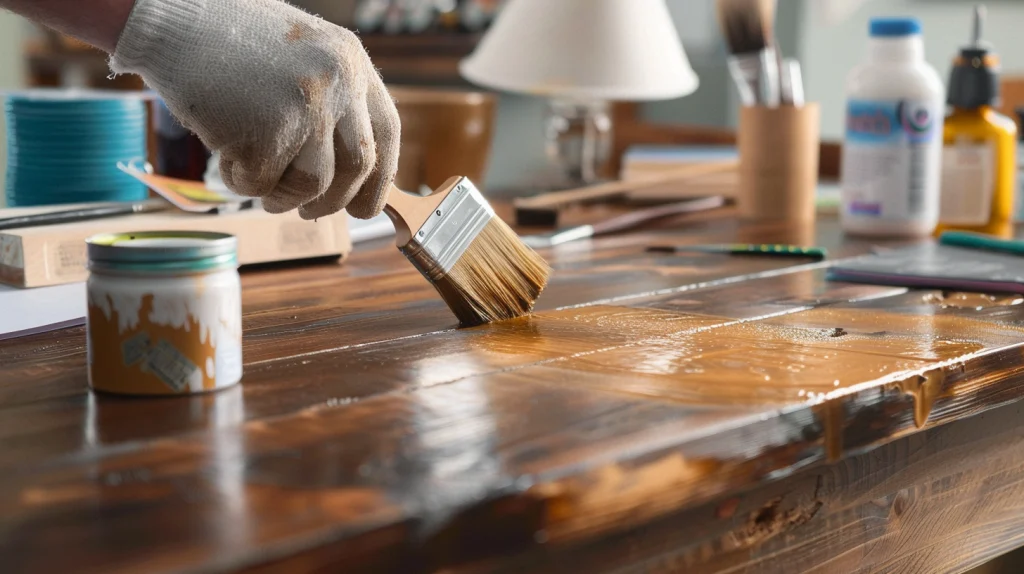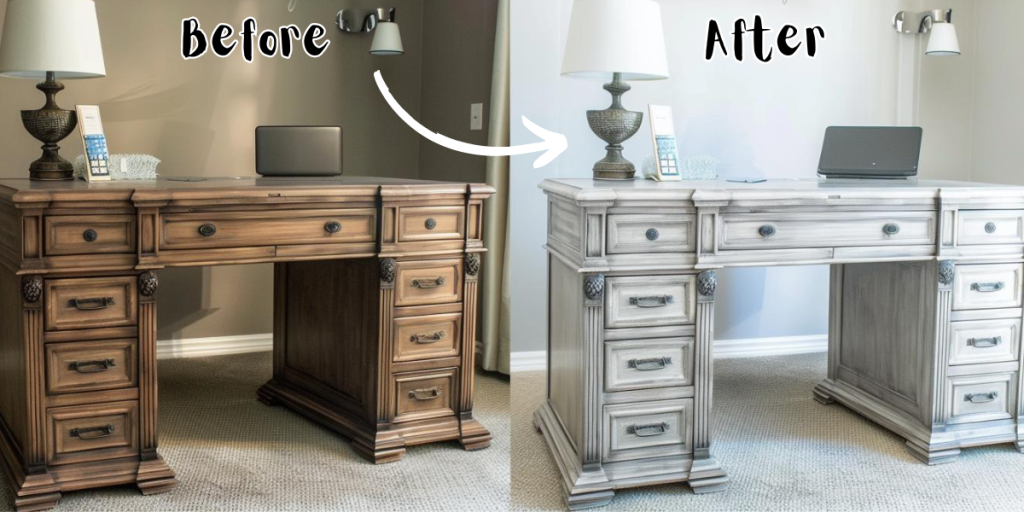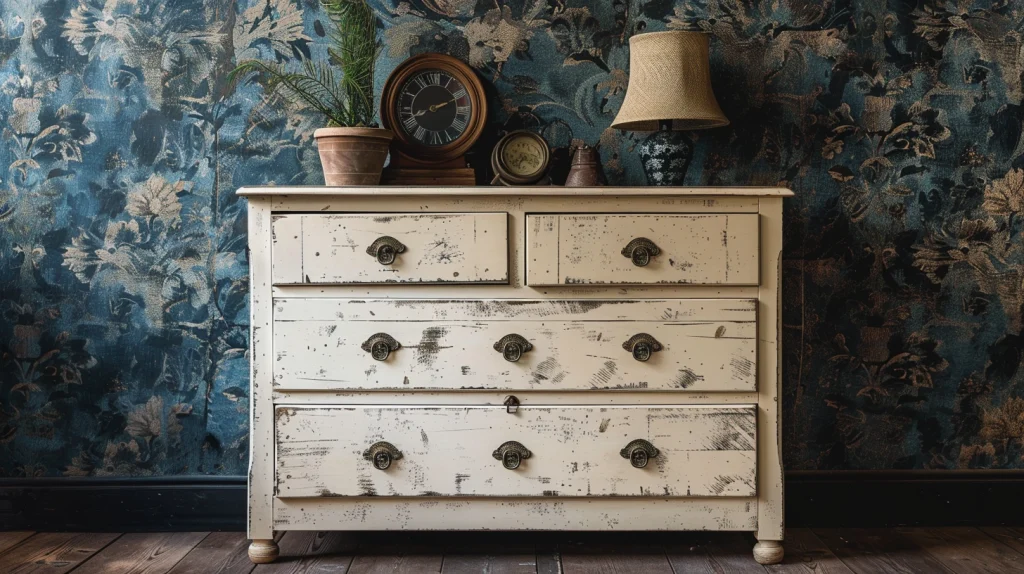Yes, you can paint over milk paint. I wanted to create a quick guide on how to paint over it though. I had some old furniture that I painted over, and there were some things I needed to figure out.
Now I want to share my experience with you so you don’t make the same mistakes that most people make.
Milk paint has been popular for several years now. However, milk paint may not always be the best choice for furniture, so you might want to paint over it.
You might decide to paint over an old piece of milk-painted furniture if you’re tired of how it looks, changing your home’s color scheme, or believe you can do a better job of painting now.
If you want to learn step-by-step instructions, make sure to stick to the end. If you have some other questions, make sure to read the whole post. For more information, check out the best milk paint and the comparison between milk paint vs. chalk paint
Can You Paint Over Milk Paint?
Yes, you can paint over milk paint. While it may seem challenging at first, with the right steps and preparation, you can achieve a smooth and beautiful finish.
Whether you’re updating an old piece of furniture or changing its color, painting over milk paint is possible. Just follow a few key steps to ensure the new paint adheres well and looks great.
(more details on that are below).
What kind of Paint Goes Over Milk Paint? Let’s Explore all the Options
When painting over milk paint, several types of paint work well. Latex paint is easy to find, affordable, and comes in many colors, though it may require a primer for better adhesion.
Acrylic paint is durable and flexible, ideal for both indoor and outdoor projects but can be more expensive. Chalk paint adheres well without primer and is easy to distress for a shabby chic look, though it typically needs wax or sealant. Oil-based paint provides a smooth, durable finish but has a longer drying time and requires mineral spirits for cleanup.
Enamel paint offers a hard, glossy finish that is easy to clean but can be more difficult to apply. Spray paint is quick and provides even coverage, making it good for small or intricate projects, though the color selection is limited.
Reapplying milk paint is also an option, as it is natural and non-toxic, but it requires a topcoat for durability. When painting over milk paint, ensure the surface is clean and lightly sanded, consider using a primer for better adhesion, and test the paint on a small area first. For added durability, especially with chalk or milk paint, seal the finish with a top coat.
Can You Paint Over Milk Paint With Regular Paint?
Yes, you can paint over milk paint with regular paint. However, it’s important to properly prepare the surface to ensure good adhesion. Start by cleaning the surface thoroughly to remove any dirt or grease.
Lightly sand the milk-painted surface to create a rough texture that will help the new paint stick better. Depending on the type of regular paint you choose (latex, acrylic, oil-based, etc.), you might also want to apply a primer for improved adhesion and coverage. Once the surface is prepped, you can proceed with applying your regular paint.
Can you Paint Over Milk Paint With Gloss Paint?
Yes, you can paint over milk paint with gloss paint. To ensure good adhesion and a smooth finish, follow these steps:
- Clean the Surface: Thoroughly clean the milk-painted surface to remove any dirt, grease, or dust.
- Sand the Surface: Lightly sand the milk paint to create a rough texture that helps the gloss paint adhere better.
- Prime the Surface: Apply a primer suitable for the surface and gloss paint. This step is especially important if the milk paint has a flat or porous finish.
- Apply the Gloss Paint: Once the primer is dry, you can apply the gloss paint. You may need multiple coats for full coverage, allowing each coat to dry completely before applying the next.
By properly preparing the surface, you can achieve a durable and attractive finish with gloss paint over milk paint.
Can You Spray Paint Over Milk Paint?
Yes, you can spray paint over milk paint. To ensure a smooth and durable finish, start by thoroughly cleaning the milk-painted surface to remove any dirt, grease, or dust.
Next, lightly sand the surface to create a rough texture that will help the spray paint adhere better. Applying a primer suitable for the surface and spray paint is also important, especially if the milk paint has a flat or porous finish.
Once the primer is dry, you can apply the spray paint in light, even coats, holding the can at the recommended distance from the surface. Allow each coat to dry completely before applying the next. By properly preparing the surface, you can achieve a smooth and durable finish with spray paint over milk paint.
Can You Paint Over Milk Paint With Satin Paint?
Yes, you can paint over milk paint with satin paint. To achieve the best results, start by thoroughly cleaning the milk-painted surface to remove any dirt, grease, or dust.
Lightly sand the surface to create a rough texture that will help the satin paint adhere better. Applying a primer suitable for the surface and satin paint is also important, especially if the milk paint has a flat or porous finish.
Once the primer is dry, apply the satin paint in even strokes, using light coats and allowing each coat to dry completely before applying the next. By properly preparing the surface, you can achieve a smooth and durable finish with satin paint over milk paint.
Can You Paint Over Milk Paint Without Sanding?
Technically, you can paint over milk paint without sanding, but the real question is, should you?
Unless you are painting over milk paint that has absolutely no sealant coat on it, you need to do some sanding before you paint. Paint just isn’t going to stick well to any type of protective coat.
If you try to paint over it without sanding, it might look like the paint went on okay, but it’s going to chip or even bubble up in a short amount of time.
If you’re trying to paint over a polyacrylic or polyurethane sealant, you don’t necessarily have to sand away every bit of it. Just sand it enough to get it scuffed up; this should be enough for your primer and/or paint to adhere well.
If you’re trying to paint over milk paint that has been sealed with wax, it’s going to take more prep work than a light sanding to get it ready for the new paint.
What If You Used Milk Paint Wax? Can You Still Paint Over It?
If you have used milk paint wax, painting over it is more challenging but possible with the right preparation. First, you need to remove as much of the wax as possible using a wax remover or mineral spirits applied with a clean cloth.
After removing the wax, clean the surface thoroughly with soap and water, then let it dry completely. Next, lightly sand the surface with fine-grit sandpaper to ensure smoothness and better paint adhesion, and remove any sanding dust with a tack cloth.
Apply a high-quality bonding primer designed to adhere to previously waxed surfaces, providing a good base for your new paint. Once the primer is dry, you can apply your chosen paint in light, even coats, allowing each coat to dry completely before applying the next.
For more information on the best products to use, check out this guide on the best chalk paint wax. By carefully removing the wax and preparing the surface, you can successfully paint over milk paint sealed with wax, ensuring proper adhesion and a durable finish.
Supplies You Need To Paint Over Milk Paint
Before getting into the details of how to do this painting project, you should gather all the necessary materials. Here is a basic list of what you will need:
- Mild Soap and Water: For cleaning the surface before you begin.
- Wax Remover or Mineral Spirits: If the milk paint has been sealed with wax, you will need this to remove the wax.
- Clean Cloths: For applying the wax remover and cleaning the surface.
- Fine-Grit Sandpaper: For lightly sanding the surface to ensure better paint adhesion.
- Tack Cloth: To remove sanding dust and debris.
- High-Quality Bonding Primer: To provide a good base for your new paint, especially if the surface was previously waxed.
- Paintbrushes or Rollers: For applying the primer and paint.
- Your Choice of Paint: The paint you plan to use for your project, such as latex, acrylic, satin, or gloss paint.
- Protective Gear: Gloves and a mask to protect yourself from dust and fumes.
- Drop Cloths or Protective Sheeting: To protect your workspace from spills and drips.
These supplies will help you prepare and successfully paint over milk paint, ensuring a smooth and durable finish.
How to Paint Over Milk Paint
Other than some extra effort to remove old finishes, the process of painting over milk paint isn’t much different from any other furniture painting project. Spread out your drop cloth, gather your supplies, and get ready for some DIY fun!
Step-by-Step Guide
- Clean the Surface: Start by thoroughly cleaning the surface with mild soap and water to remove any dirt, grease, or dust. Let it dry completely.
- Remove Wax (if applicable): If the milk paint has been sealed with wax, use wax remover or mineral spirits on a clean cloth to remove the wax. Wipe the surface until the wax is no longer present.
- Sand the Surface: Lightly sand the entire surface with fine-grit sandpaper to create a rough texture that helps the new paint adhere better. If you remove wax, this step is crucial to ensure the new paint sticks well.
- Clean the Surface Again: Use a tack cloth to wipe away any sanding dust and debris, ensuring a clean, smooth surface.
- Apply Primer: Apply a high-quality bonding primer to the surface. This is especially important if the surface was previously waxed or if you’re using a paint that requires a primer for better adhesion. Let the primer dry completely according to the manufacturer’s instructions.
- Paint: Once the primer is dry, apply your chosen paint. Use even strokes and light coats, allowing each coat to dry completely before applying the next. Depending on the type of paint and the color you’re using, you may need multiple coats for full coverage.
- Finish and Seal (optional): If desired, apply a sealant to protect your new paint job, especially if the furniture or item will see a lot of use.
By following these steps, you can successfully paint over milk paint and achieve a smooth, durable finish on your project.
Finally, I want to remind you to take some before and after pics of your project! It’s fun to compare them and see what an amazing transformation can be achieved with a new paint job!



Leave a Reply